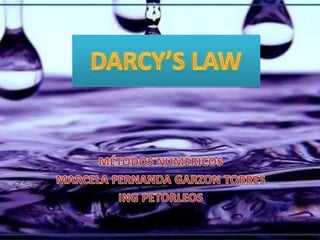
Ley de darcy
- 1. DARCY’S LAW MÉTODOS NUMÉRICOS MARCELA FERNANDA GARZON TORRES ING PETORLEOS
- 2. CONTRIBUTION OF HENRY PHILIBERT GASPARD DARCY Henry Darcy (1803 to 1858) invented the modern style Pitot tube, was the first researcher to suspect the existence of the boundary layer in fluid flow, contributed in the development of the Darcy-Weisbach equation for pipe flow resistance, made major contributions to open channel flow research and of course developed Darcy's Law for flow in porous media. His Law is a foundation stone for several fields of study including ground-water hydrology, soil physics, and petroleum engineering
- 3. DARCY´S LAW One application of Darcy's law is to water flow through an aquifer. Darcy's law along with the equation of conservation of mass are equivalent to the groundwater flow equation, one of the basic relationships of hydrogeology. Darcy's law is also used to describe oil, water, and gas flows through petroleum reservoirs
- 4. In hisexperimentDarcyalsofoundthatif he useddifferrentkinds of sands in thecolumn, discharge Q changed, butfor a particular sand, regardless of Q: Q = -KA(dh/dl) EQUATION DEVELOPMENT (Bradley and Smith, 1995)
- 7. A:area perpendicular al flujo
- 8. U:viscosidad
- 9. L:longitud
- 11. BIBLIOGRAPHY web.usal.es/~javisan/hidro/temas/T080.pdf www.cec.uchile.cl/~ci51j/txt/Apuntes/Tema03.pdf www.worldlingo.com/ma/enwiki/es/Darcy's_law www.ees.nmt.edu/Hydro/courses/erth441/.../L2_Darcys_Law.pdf www.ajdesigner.com/phpdarcyslaw/darcys_law_equation_flow_rate.php